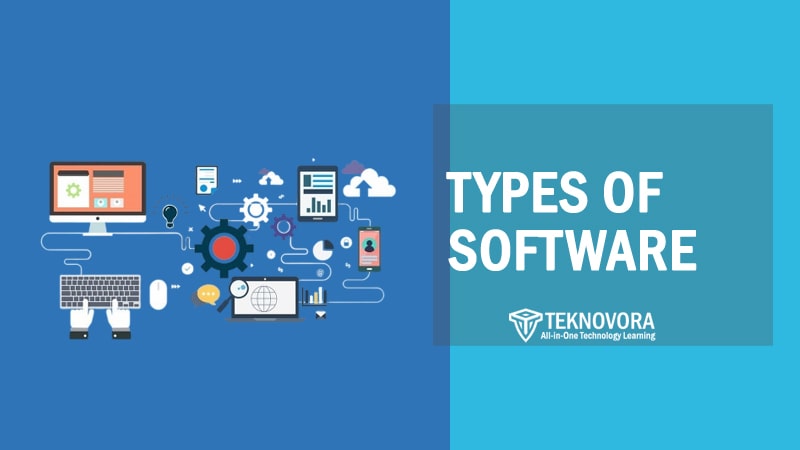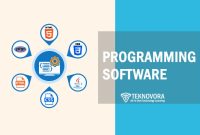From the moment you power on your device to the second you close your last tab, software is running behind every action. Whether you’re typing a report, watching a video, browsing the internet, or backing up important files, different types of computer software are silently working together to make it all possible.
But not all software is created equal. Some programs are designed to manage your device’s core operations, while others are built to help you perform specific tasks or keep your system secure and efficient. Understanding the types of computer software—and how they interact—can help you become a smarter user, a better decision-maker, or even a more capable developer.
In this article, we’ll break down the major classifications of software, provide real-world examples, and explain how each type plays a role in your everyday digital experience.
What Is Computer Software?
Computer software refers to a collection of instructions, data, or programs used to operate computers and perform specific tasks. Unlike hardware—which is the physical part of a computer—software is intangible. It tells your machine what to do, how to do it, and when to do it.
Without software, even the most powerful hardware is essentially useless. It’s the software that enables you to open applications, browse the web, play music, write code, or even run diagnostics on your device.
There are many types of computer software, each created for a distinct purpose. Some control how the hardware communicates, while others let you interact with the system, enhance security, or develop new tools altogether.
At a high level, software can be categorized based on function, structure, or use case. In the next section, we’ll explore how experts typically classify these types of software into five major categories—each with its own role in the computing ecosystem.
Main Classifications of Computer Software
Computer software is typically grouped into five main categories based on its purpose and function. Each type plays a specific role in managing hardware, enabling user interaction, or supporting other software systems. Understanding these categories gives you a clearer picture of how your device functions holistically.
Let’s break down the core types of computer software, starting with the most fundamental: system software.
System Software
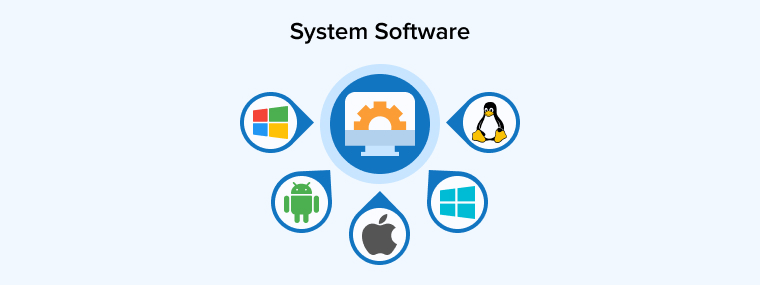
System software is the foundational layer that controls and manages the hardware components of a computer. It serves as a bridge between the user and the machine, ensuring that applications can run efficiently while the hardware remains accessible.
Key functions:
- Manages system resources like memory, processors, and input/output devices
- Provides a platform for running application software
- Controls basic device operations during startup and shutdown
Examples of system software:
- Operating Systems: Windows, macOS, Linux, Android, iOS
- Device Drivers: Printer drivers, GPU drivers, USB drivers
- Firmware: BIOS, UEFI
- System Utilities: File management, task schedulers
Without system software, your device wouldn’t be able to boot up, interpret user commands, or allocate resources to different tasks. It’s the first software to load and the last to close.
Application Software

Application software is the category of programs designed to help users perform specific tasks. This is the type of software you interact with most often—whether you’re editing documents, streaming videos, managing finances, or joining a video call.
Unlike system software, which runs in the background, application software is task-focused and directly tied to your daily workflow.
Key functions:
- Enables productivity (e.g., word processing, spreadsheets)
- Facilitates communication (e.g., email, video conferencing)
- Supports creativity and entertainment (e.g., design, gaming, streaming)
Examples of application software:
- Office Tools: Microsoft Word, Excel, Google Docs, Notion
- Web Browsers: Google Chrome, Mozilla Firefox, Safari
- Media Players: VLC, Spotify, Netflix apps
- Design Software: Adobe Photoshop, Figma, Canva
- Communication Tools: Zoom, Slack, Microsoft Teams
Application software depends on system software to function. For example, a browser runs on top of the operating system, while accessing hardware (like a webcam) through drivers provided by system-level components.
While this is the most visible among all types of computer software, it’s only part of the broader ecosystem.
Utility Software
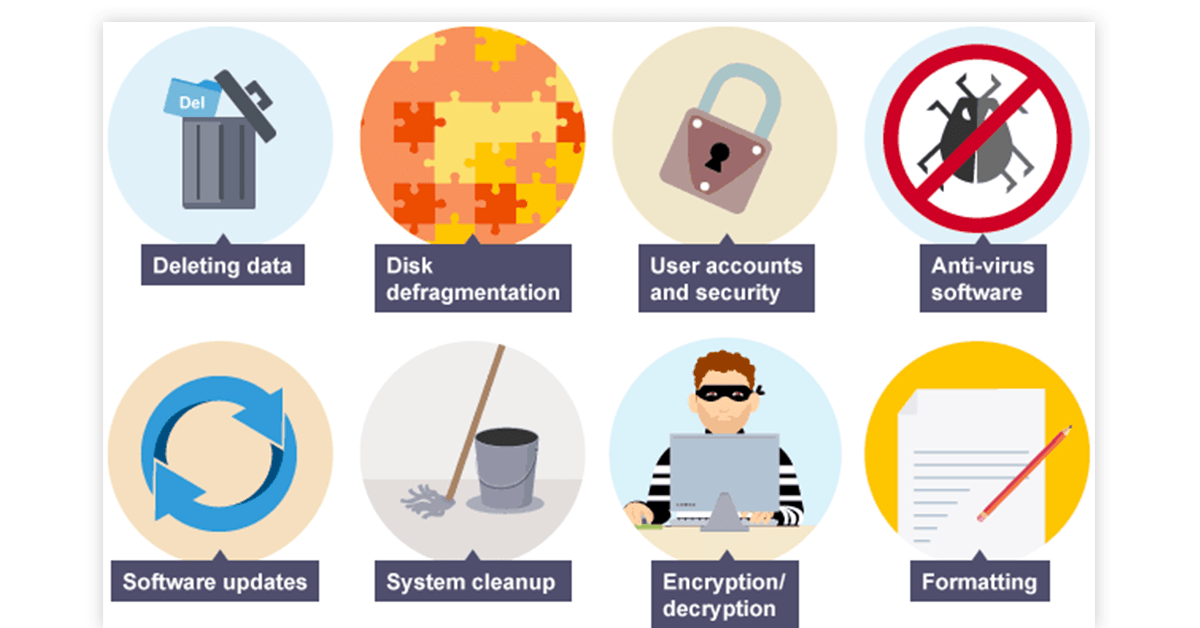
Utility software is designed to optimize, secure, maintain, and manage your computer system. While system software lays the foundation and application software performs tasks, utility software ensures everything runs smoothly in the background.
These tools often work quietly but are essential for long-term system health and user efficiency.
Key functions:
- Clean up unnecessary files and temporary data
- Protect against malware and other threats
- Manage disk storage and backups
- Monitor hardware performance and system resources
Examples of utility software:
- Antivirus Tools: Bitdefender, Avast, Windows Defender
- Disk Cleaners: CCleaner, CleanMyMac
- Backup Tools: Acronis True Image, Macrium Reflect, Time Machine
- System Monitors: Task Manager (Windows), Activity Monitor (macOS), htop (Linux)
Utility software works alongside both system and application software. For instance, while you’re working on a document (application), your antivirus (utility) might scan for threats, and a system cleaner could optimize disk space in the background.
This category demonstrates how different types of computer software collaborate to create a balanced computing experience.
Programming Software
Programming software provides the tools developers need to write, test, debug, and maintain other software applications. While the average user might never directly interact with this category, it’s the backbone of all modern software development.
This type of software is primarily used by software engineers, web developers, and system architects to create the very applications and systems that people use every day.
Key functions:
- Write and edit code in various programming languages
- Compile source code into executable programs
- Debug errors and optimize performance
- Manage dependencies and version control
Examples of programming software:
- IDEs (Integrated Development Environments): Visual Studio, IntelliJ IDEA, Eclipse
- Text Editors: VS Code, Sublime Text, Atom
- Compilers: GCC (C/C++), javac (Java), Swift Compiler
- Debuggers: GDB, LLDB
- Version Control Tools: Git, GitHub Desktop, GitLab
Programming software doesn’t typically run on its own—it supports the creation of other software types. For instance, a developer may use VS Code (a programming tool) to build a new application (application software), which will eventually run on an operating system (system software).
It plays a key role in expanding and evolving the entire ecosystem of types of computer software, ensuring that new tools and innovations can continue to emerge.
Middleware
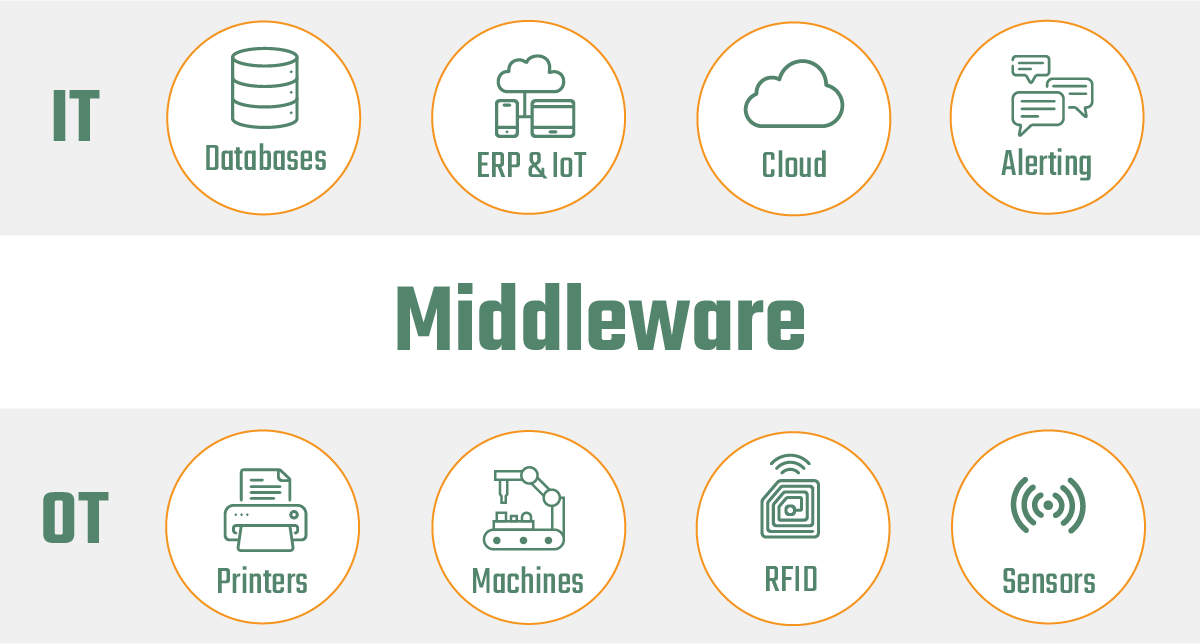
Middleware is a specialized type of computer software that acts as a bridge between different applications, systems, or software components. While it’s mostly invisible to end users, it plays a vital role in enabling communication and data exchange—especially in enterprise and cloud environments.
Middleware sits between system software and application software or between two applications, allowing them to work together even if they were not originally designed to interact.
Key functions:
- Facilitates data exchange between different software components
- Manages requests between clients and servers
- Provides APIs and communication protocols
- Supports distributed computing and cloud integration
Examples of middleware:
- Database Middleware: ODBC, JDBC
- Message-Oriented Middleware (MOM): RabbitMQ, Apache Kafka
- Remote Procedure Call Systems: gRPC, CORBA
- API Gateways: Kong, Amazon API Gateway, NGINX
- Web Middleware: Node.js Express, Django middleware, Laravel middleware stack
In large-scale environments, such as enterprise software systems or cloud-native applications, middleware enables scalability, modularity, and system interoperability. It allows a web app to communicate with a database, or a mobile app to connect securely to a cloud-based API.
While middleware may not be as familiar as other types of computer software, its importance is growing—especially as software systems become more distributed, service-based, and interconnected.
How These Software Types Work Together
Although each type of computer software serves a distinct purpose, they rarely operate in isolation. In fact, most of your everyday digital activities rely on multiple software types working together—seamlessly and simultaneously.
Let’s break down how these layers interact:
1. System Software as the Foundation
System software like your operating system initializes the hardware and sets up the environment for everything else to function. It allocates resources like memory and CPU time, loads drivers, and manages processes.
Without it, no other software could run.
2. Application Software on Top of the System
Application software relies on system software to function. When you open a browser or a document editor, the operating system is responsible for launching the app, managing files, and handling input/output.
Example:
- When you open Microsoft Word (application software), Windows (system software) handles the loading process, manages your device’s RAM usage, and lets the app access the printer driver.
3. Utility Software Working in the Background
While you’re using applications, utility software helps keep the system clean and secure. It may scan files for malware, monitor CPU temperature, or automatically back up your documents.
Example:
- While you’re editing a file in Google Docs, your antivirus might scan downloads in the background, and a disk cleaner may remove temporary files after you close the browser.
4. Programming Software Behind the Scenes
Every application and system tool you use was once built using programming software. Developers use compilers, debuggers, and IDEs to create, test, and refine software across all categories.
Example:
- Google Chrome was built using C++ in a programming environment before being distributed to billions of users as application software.
5. Middleware Connecting It All
In enterprise environments or cloud-based applications, middleware connects the system software, application layers, and databases—especially across networks or platforms.
Example:
- When you use a banking app, middleware enables communication between the front-end interface (application), back-end services (database software), and authentication systems—all in real time.
Together, these types of computer software form a layered architecture. Each layer depends on the others to deliver speed, security, flexibility, and user functionality—whether on a personal laptop or a multi-server enterprise network.
Why Understanding Software Types Matters
Knowing the different types of computer software isn’t just useful for IT professionals—it’s increasingly valuable for anyone who uses digital devices regularly. From choosing the right tools to solving performance issues, a basic understanding of software categories can empower smarter decisions and better results.
Here’s why it matters:
1. Smarter Software Selection
When you understand what each type of software is designed to do, you can choose the right tools for the job. For example:
- Want to speed up your PC? → You need utility software.
- Need to write code or test an app? → You’ll want programming software.
- Looking to edit a photo or record a podcast? → That’s the role of application software.
2. Improved Troubleshooting and Maintenance
Knowing how system, utility, and application software interact helps in diagnosing problems. You’ll be better equipped to:
- Identify whether a slow computer is caused by an app or system process
- Know when to update drivers versus uninstall an unused program
- Spot conflicts between antivirus software and system updates
3. Enhanced Digital Security
Some software types, like utilities and middleware, play a critical role in security. Understanding them helps you:
- Choose reliable antivirus tools
- Use backup and encryption software correctly
- Avoid downloading harmful or unnecessary programs
4. Career and Skill Development
Whether you’re a student, aspiring developer, or tech enthusiast, understanding software categories is foundational knowledge in:
- Computer science and software engineering
- Network administration and cloud infrastructure
- Digital product development and UI/UX design
5. Stronger Decision-Making in Business and IT
In enterprise settings, understanding software types is essential for:
- Planning software architecture
- Choosing the right platform or stack
- Scaling and securing digital systems
Ultimately, the more you understand the types of computer software, the more control, confidence, and clarity you’ll have in navigating technology—whether as a user, a creator, or a decision-maker.
Examples in Daily Life
Understanding the types of computer software is one thing—seeing them in action is another. Every time you use a device, you’re engaging with multiple software types working together behind the scenes. Let’s explore how that happens in common, real-world scenarios.
Scenario 1: Writing a Document
- System Software: Your operating system (e.g., Windows) boots up your laptop.
- Application Software: You open Microsoft Word or Google Docs to write.
- Utility Software: Antivirus scans any document downloads or email attachments in real time.
- Programming Software: The tools used by developers to create Word or Docs (e.g., Visual Studio, JavaScript frameworks).
- Middleware (optional): If you’re accessing cloud-stored documents, middleware helps Word communicate with OneDrive or Google Drive.
Scenario 2: Streaming a Movie Online
- System Software: Manages memory, audio output, and screen resolution.
- Application Software: You launch Netflix or another streaming app.
- Utility Software: Bandwidth monitor or firewall tool manages internet traffic.
- Middleware: Delivers video content from server to client via streaming protocols (e.g., DASH or HLS).
- Programming Software: Used to develop the app interface and backend engine.
Scenario 3: Developing a Mobile App
- System Software: The OS of the development machine, plus mobile emulators.
- Programming Software: An IDE like Android Studio, code editor, compilers.
- Application Software: Simulated version of the mobile app being tested.
- Utility Software: Debuggers, performance monitors, or version control systems.
- Middleware: Connects app APIs to cloud services or third-party integrations.
Quick Reference Table: Software Types at Work
| Task | System | Application | Utility | Programming | Middleware |
|---|---|---|---|---|---|
| Writing an article | ✅ | ✅ | ✅ | ✅ | (optional) |
| Watching YouTube | ✅ | ✅ | ✅ | ✅ | ✅ |
| Coding a website | ✅ | ✅ | ✅ | ✅ | ✅ |
| Managing cloud backups | ✅ | ✅ | ✅ | ✅ | ✅ |
| Playing a video game online | ✅ | ✅ | ✅ | ✅ | ✅ |
These scenarios show how all types of computer software operate together in real-time, regardless of how simple or complex the task may seem. Most of this interaction is seamless and invisible—but essential to the experience.;
Current Trends in Software Types
The software landscape is constantly evolving. While the fundamental types of computer software remain the same, how they are developed, delivered, and used is rapidly changing. Let’s take a look at some of the most important trends influencing all software categories today.
1. Cloud-Based Software Delivery

Many applications and utilities are no longer installed locally—instead, they run entirely through the cloud. This trend affects everything from word processors to antivirus systems.
- Impact: Lower hardware requirements, automatic updates, and better cross-device access.
- Examples: Google Workspace (application), Carbonite (utility), AWS Lambda (middleware/system-level functions)
2. Software-as-a-Service (SaaS) Model
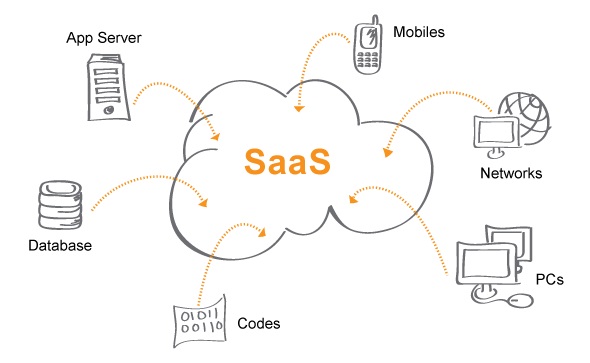
Software is shifting from one-time purchases to subscription-based services. SaaS platforms bundle application, system, and sometimes middleware software into one ecosystem.
- Impact: Scalable pricing, real-time collaboration, continuous deployment
- Examples: Microsoft 365, Adobe Creative Cloud, Salesforce
3. Artificial Intelligence Integration

AI is now built into all types of software—from productivity apps to system utilities—enhancing automation and predictive capabilities.
- Impact: Smarter optimization, personalized experiences, real-time threat detection
- Examples: AI-based antivirus, auto-enhance tools in design apps, code assistants like GitHub Copilot
4. Open-Source and Community-Driven Tools

More users and developers prefer open-source options across software types for transparency, customization, and cost-effectiveness.
- Impact: Greater innovation and faster security patching
- Examples: Linux (system), LibreOffice (application), GIMP (utility), Eclipse (programming)
5. Cross-Platform Compatibility

Modern software is increasingly built to work across devices and operating systems—bridging the gap between desktop, mobile, and cloud environments.
- Impact: More flexibility and user access
- Examples: Progressive Web Apps (PWAs), Flutter (development), OneDrive sync across platforms
6. Merged Software Functions

Lines between software types are blurring. Antivirus tools now offer system monitoring, text editors come with compiler support, and operating systems have built-in utilities.
- Impact: More integrated user experiences
- Examples: Windows 11 with built-in backup, Apple ecosystem combining system, app, and utility functions
These trends reveal that while the types of computer software remain conceptually the same, their roles are becoming more interconnected and intelligent than ever before.
Conclusion
Understanding the different types of computer software is key to mastering how digital systems operate. From system software that runs in the background, to the applications we use every day, to the utility tools that keep everything secure and fast—each category plays an essential role.
These layers don’t work in isolation. They collaborate constantly to deliver the seamless experience we expect when using our devices. Whether you’re a casual user, a developer, or a decision-maker in IT, knowing how these software types function and interact helps you make smarter choices, troubleshoot issues more effectively, and stay informed in a tech-driven world.
As technology continues to evolve—especially with trends like AI, cloud computing, and cross-platform integration—the core types of computer software remain vital. And the better we understand them, the better we can use, manage, and even build the technology of tomorrow.;
FAQ: Types of Computer Software
What are the main types of computer software?
The primary types of computer software include system software, application software, utility software, programming software, and middleware. Each serves a unique purpose—from running your device and enabling user tasks to supporting software development and integration.
How is system software different from application software?
System software manages core functions like hardware control, memory management, and file systems. Application software, on the other hand, helps users perform specific tasks—like writing documents, browsing the web, or editing images.
Can a single program fall into more than one software category?
Yes. Some programs combine features from multiple categories. For example, an integrated development environment (IDE) like Visual Studio offers both programming and utility functions. Similarly, cloud-based platforms often blend application, system, and middleware features.
Why is middleware important in modern computing?
Middleware allows different software systems—like apps, databases, and servers—to communicate smoothly. It’s essential for distributed applications, cloud services, and large enterprise systems where integration is key.
Do mobile devices use the same software types as computers?
Yes. Smartphones and tablets use all major types of computer software, including operating systems (Android, iOS), application software (apps), utility tools (battery managers, antivirus), and middleware to manage communication between apps and servers.

